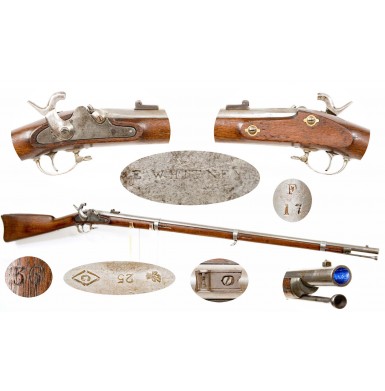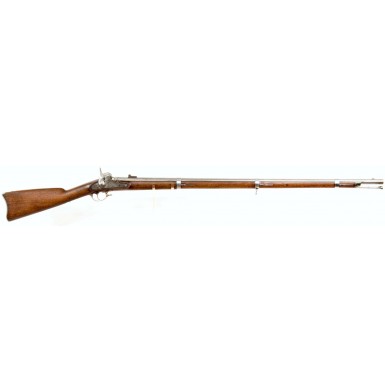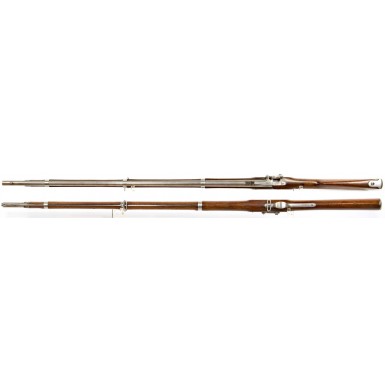Whitney High Hump M1855/61 Variant Rifle Musket - Very Rare
- Product Code: FLA-3575-SOLD
- Availability: Out Of Stock
-
$3,750.00
The “Good and Serviceable Arms” produced by the Whitney Arms Company are some of the most interesting, unique and in many cases the scarcest of all Civil War era military long arms. The arms were produced in a variety of patterns and styles by Eli Whitney Jr., and in many cases utilized surplus (and in some cases condemned) parts from other Whitney contracts, as well as from other manufacturers. Whitney had expended a significant amount of capital in the completion of his US Ordnance Department contracts for Model 1841 “Mississippi” rifles and found himself to have lost money at the completion of the production run. In Whitney’s mind, the largest contributing factor to the lack of profitability was the need for the guns to be fully interchangeable, and the stringent gauging and inspection that US contract arms were subject to significantly increased his production costs. As such, he proposed to produce guns that would be (in his words): “good & serviceable arms, not to be subject to government inspection with gauges.” It is somewhat ironic that the “American System of Manufacturing” (the production of items on the basis of interchangeable parts), the very concept that built the company under his father’s tenure, was seen as the biggest problem for the company by Whitney’s son. Since Whitney relied upon small lots of parts, which he purchased for pennies on the dollar, most of the models produced were in very small quantities - rarely exceeding 1,000 of any one pattern. Whitney procured parts by buying obsolete, surplus, over run and even condemned parts from Europe, Robbins & Lawrence, and the American armories at both Springfield and Harper’s Ferry. The “Good & Serviceable” models resembled US M1841 “Mississippi” type rifles, British P1856 and P1853 “Enfield” style rifles and rifle muskets, US M-855 rifles and rifle muskets, as well as other patterns that were purely of Whitney’s design. The guns were offered for sale to states and private militia groups at a lower price than his competitors could meet, but due to his frugal production methods and minimal outlay for parts, the guns proved to be a very profitable venture for Whitney.
One of the rarest examples of Whitney’s “Good & Serviceable” arms was the US Model 1855/61 “High Hump” Rifle Musket (Flayderman 5J-047.5). Unlike Whitney’s small batch of about three hundred and fifty US 1855 pattern rifle muskets produced with functional tape primer mechanisms, these arms were assembled with “High Hump” 1855 type locks that were not completely milled and finished. Like so many of the Whitney “Good & Serviceable” arms, the guns were produced with varying features that depended upon the parts available to use in their production. In general, these arms basically followed the US 1855 pattern, or more accurately the Richmond “High Hump” pattern. The un-milled tape primer locks were left at their full height with a prominent hump, and were mated to a 40”-long, .58 caliber barrel that was secured by three flat, spring-retained bands and a tang screw. Some of the barrels were rifled with Whitney’s signature 7-groove pattern and others were rifled with the usual US 3-groove pattern. Instead of the usual US iron nosecap, Whitney typically used a pewter one. Most mountings were of iron, with some the guns made with winged brass side nail caps that were basically of Enfield pattern. The rear sight was a short base, Whitney “mid-range” leaf sight or a condemned US M1861 pattern rear sight. The use of condemned or surplus US parts (like the lock plates), as well as components from other sources was not uncommon and the only truly common thread through most of the production was a level of inconsistency in the features of each gun.
While the documentation regarding the 350 Whitney-made US 1855 pattern rifle muskets with functional tape primers is fairly complete, there remains much conjecture regarding the manufacture and sale of the non-functional tape primer 1855 “High Hump” rifle muskets. The 350 “functional” M1855s were sold to the state of Connecticut and it is hypothesized that some of the non-functional M1855s were sold to that state as well, as there is a small amount of period photographic evidence that places at least a few of these “High Hump” guns in the hands of members of the 21stConnecticut Infantry. Section 375 of George Moller’s seminal American Military Shoulder Arms Volume III provides the essential available information regarding these muskets. He notes that Fredrick Todd had indicated that the state of Maryland had acquired “2,000 rifle muskets Model 1855, cal. 58 from Eli Whitney, Jr., of New Haven, Conn.” Moller’s research notes that these guns were all delivered by early 1861. 1,630 of these guns were subsequently issued to pro-Union Maryland volunteer militia, while the remaining 370 were stolen by rioters on April 19, 1861. It appears likely that those stolen guns ended up in pro-Southern hands. Moller also discusses an 1860 order for rifle muskets placed with Whitney by the State of Georgia. At least 1,220 guns were delivered under the terms of this contract, but it is unclear how many might have been of the “high hump” variety, although he suggests that at least a few were. Moller does not estimate the production figures for the guns but infers that some 2,000 to 3,000 were produced. Interestingly, Flayderman’s only estimates the total production of these guns at around 200. Considering the extremely low survival rate and their overall scarcity on the collector’s market, he may have been close to correct. It is also possible that the guns were produced in two different production runs, as 3-groove rifling did not become common on the Whitney “Good & Serviceable” arms until sometime in 1862. This would suggest that any gun so rifled may not have been part of the original Maryland contract, and certainly could not be part of the Georgia contract. Complaints about the quality of the arms delivered under the Maryland contract are well documented, so it is also possible that some of the 3-groove guns may have been later replacement muskets. The only thing that is definite about this Whitney 1855 variant rifle musket is that they are very scarce. Over the past two decades I have owned two of the 350 functional tape primer Whitney 1855s, but this is the first “high hump” I have ever had. That suggests that Flayderman’s production figures may be a fairly accurate guess.
The Whitney US Model 1855/61 “High Hump” Rifle Musket offered here is in about VERY GOOD+ condition overall. The gun shows a mixture of what Moller would call “Type I” and “Type II” features, as well as a barrel that is more often associated with the functional tape primer 1855 Whitney guns. The “High Hump” lock is marked in two-lines: E WHITNEYover NEW HAVEN. The top line of the marking is slightly weak and the lower line is almost completely illegible, with the exception of the “N” at the end of “New Haven”. When the lock is removed from the stock it is clear that the lock was assembled with 1855 type parts, including the triangular stirrup that has not been cut to operate the tape primer feed arm. The later M1861 stirrup eliminated the shape that would allow the pivoting feed arm to attach to it. The interior of the lock shows the rough filing and finishing that is often associated with Whitney’s good and serviceable arms.
The barrel of the gun is a surplus, British made, Colt contract barrel. These 40” barrels were purchased by Colt from the Birmingham gun trade, in hopes of using them to build US M1861 Special Model Rifle Muskets. When the Ordnance Department refused to accept these English made barrels, Colt dumped them on the Birmingham gun parts market. They are readily identifiable by the <C> mark upper left angle flat, which has provided their collector nickname of “Diamond-C” barrels. These Colt surplus barrels were used by a number of makers and appear on some Confederate marked P1853 Enfields as well as some US contract guns. The flat is additionally marked with a commercial Birmingham proof mark, a 25 gauge mark (.577 caliber) and a small S. The underside of the barrel is marked with a weak EZRA MILLWARD mark, the name of the Birmingham barrel maker, an Mand a 2. The .58 caliber bore is rifled with three-grooves that show tool marks and a generally low level of finishing. Whitney appears to have acquired these barrels from Sairel Lehman in Great Britain, via Schuyler, Hartley & Graham of New York. These barrels have been noted on Whitney’s “Enfield” style rifle muskets as well as on some of his functional tape primer 1855 type rifle muskets. In the usual Whitney fashion, there is an alphanumeric serial number on the top of the barrel, in this case F /17. The number is stamped behind the rear sight, near the nose cap. The barrel is secured by three flat, spring-retained bands that are marked with the typical US “U” for up. The rear sight is a Whitney “mid-range” leaf sight, secured by a single screw and mounted in a shallow dovetail. The front sight is the standard musket style combination sight and lug for an angular socket bayonet. All of the furniture is of iron, with the exception of the brass Whitney “Enfield” style winged lock screw washers. The buttplate is unmarked. The forend cap is pewter and retained by two pins. The thick, straight shank ramrod has a tulip shaped head and appears to be one of the two correct pattern ramrods for this pattern of Whitney musket. The shape is slightly different than a US Springfield or contract ramrod of the same pattern. The stock is an appropriate Whitney 1855 style stock with a “mule’s foot” in the mortise and no mortise cut for the Maynard feeder arm. The lock mortise is very similar to those found on Richmond made stocks. In all respects the gun appears to be of original and correct Whitney parts that appear to have always been together with the possible exception of the rear sight, which is slightly oxidized and may be a correct replacement.
As previously noted, the gun remains in about VERY GOOD+ condition. The metal has been lightly cleaned to bright, resembling its original “arsenal bright” finish. There is some light pitting present around the breech and bolster area, which has been smoothed by the cleaning. The metal does show some scattered flecks of minor surface oxidation and some age discoloration. The alphanumeric mark on the barrel remains crisp and clear and is completely legible. The marks at the breech remain crisp and clear as well. The “U” markings on the bands also remain crisp and clear. The bore of the gun is in about VERY GOOD+ condition as well and is nearly “fine”. It is mostly bright, with some scattered oxidation and lightly scattered pitting. As noted, the rifling shows tool marks and an overall lower level of quality than is usually associated with most US contract made guns of the period. The correct pattern rear sight is in place near the breech. The L-shaped “mid-range” sight shows traces of blue with a moderately oxidized brown patina. The leaf and base remain fully intact and the screw that secures the sight shows some slot wear. The original front sight/bayonet lug is in place near the muzzle and both original sling swivels remain in place as well. What appears to be the original and correct Whitney pattern ramrod is in the channel under the stock. The rod is full-length with fine threads at the end. The stock of the gun rates about VERY GOOD+ to NEAR FINE. It is full-length and is free of any breaks, cracks or repairs. The rack number 36 is stamped into comb of the stock, forward of the buttplate tang. The stock appears to have been lightly cleaned but retains very nice edges and lines and was certainly never sanded aggressively. As is often the case with Whitney “Good & Serviceable” arms, the wood to metal fit is not quite Springfield Arsenal quality, but it is certainly workmanlike. Otherwise, the stock shows only the normal bumps, dings and handling marks from service and use in the field.
Overall this is a very attractive and extremely scarce rifle musket, of a pattern that is rarely encountered for sale. Whitney military arms could be a collecting specialization in and of themselves. For an advanced collector of US military long arms from the Civil War era, any of the Whitney M1855 variant long arms would be a real coup to add to their collection. Most “Good & Serviceable” Whitney arms are rather scarce, but his Enfield pattern guns do appear on the market from time to time. I have had the privilege to offer a few of those Enfield style guns over the years. As noted, I have had the chance to sell two Whitney functional tape primer M1855 rifle muskets over the years, but never a non-functional “High Hump” 1855/61 variant. This gun comes from a very advanced and significant, long-time collection US rifle muskets and contract arms, and is fresh to the market. It was originally located in the Massachusetts area some 30 or 40 years ago and has only changed hands once during that period. Although production figures are unknown, the Flayderman estimate of only a couple hundred appears quite plausible. The location it was found also makes sense considering the photographic evidence that at least a few of these guns saw use with the 21stConnecticut Volunteer Infantry. This is one of those very rare secondary US martial rifle muskets from the American Civil War that is missing from even some of the most advanced collections and that rarely appears on the market. This would be a real coup to add to your collection, and I am quite sure you would be very pleased with its acquisition.
SOLD
Tags: Whitney, High, Hump, M1855/61, Variant, Rifle, Musket, Very, Rare













